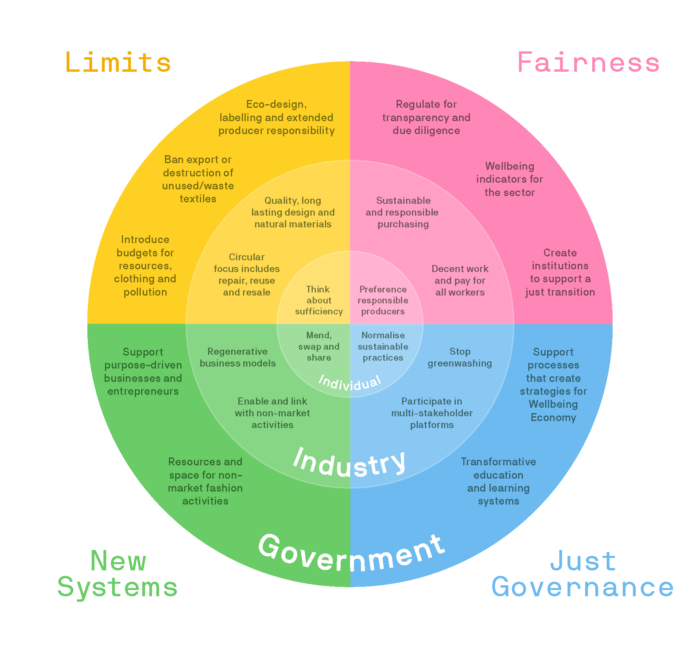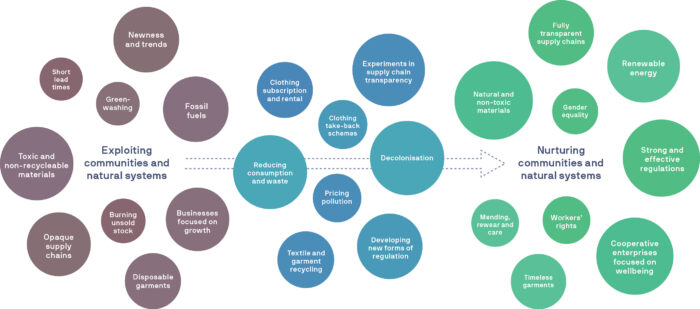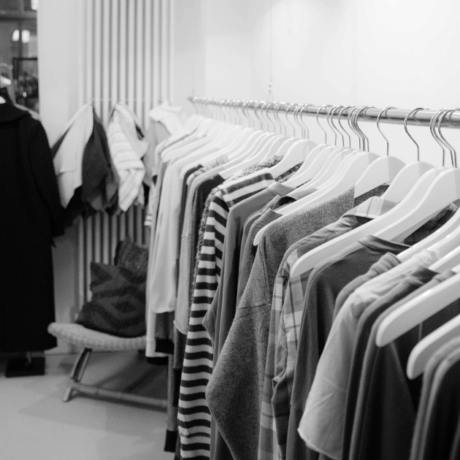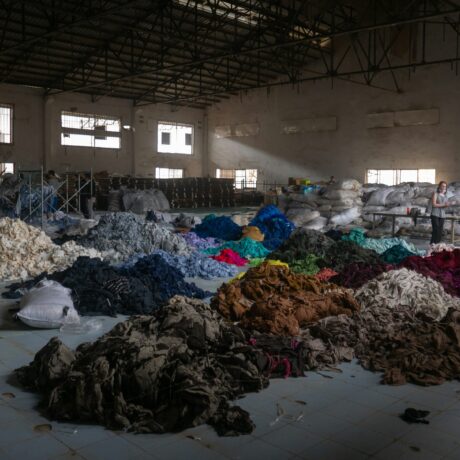The Wellbeing Wardrobe: A Path Forward?
This is a guest post written by Taylor Brydges, Research Principal, and Samantha Sharpe, Research Director, at the Institute for Sustainable Futures, at the University of Technology Sydney (UTS) . The European Environmental Bureau (EEB) commissioned a team from UTS, the Institute for Sustainable Futures (ISF), Erasmus University Rotterdam and Lund University to develop the concept of a ‘Wellbeing Wardrobe’ – a fashion and textiles industry that is oriented towards a Wellbeing Economy.
Clothes are an essential part of our daily lives. While our clothing choices reflect our culture and identity, our clothing and the fashion industry’s environmental impact can’t be ignored.
Fashion is one of the most unsustainable industries in the world based on environmental and social sustainability metrics. Over the past decades, the sector’s rapid growth has been fueled by overproduction and overconsumption of garments. Recognising that fashion has become one of the most unsustainable industries in the world also requires us to confront the reality that we need a new way forward.
However, many of the current sustainability initiatives in the fashion industry are based on green-growth approaches that put economic opportunity before environmental concerns. At the core of many of these business models are initiatives that do not fundamentally overhaul the industry or allow it to operate within planetary boundaries. Examples of such approaches include shifting to more sustainable fibres and textiles, providing a limited range of ethically conscious options, or introducing ‘green’ certification and labelling systems.
Although these initiatives provide some progress, they ultimately fail to enable the industry to reduce material consumption or prevent the unnecessary disposal of clothing and textiles. This failure results in increased carbon emissions, natural resource utilisation, and biodiversity loss. If the fashion industry doesn’t change its current trajectory, it might consume over 26% of the carbon emissions allowance linked to a 2-degree Celsius limit on global warming by 2050.
Introducing The Wellbeing Wardrobe
Our recent report, The Wellbeing Wardrobe, set out to explore how we can achieve a post-growth fashion industry. We found this will require far-reaching reforms beyond the fashion industry and a reconceptualisation of societal roles and responsibilities. This led us to focus on the wellbeing economy.
The “wellbeing economy” concept encompasses various alternative economic models, including degrowth, post-growth, and steady-state economics. It aims to shift our focus from economic growth to human and ecological wellbeing.
Applied to the fashion industry, we use the concept of the wellbeing wardrobe to examine a new way forward for fashion in which we favour human and environmental wellbeing over the growing consumption of fashion.
The Wellbeing Wardrobe identifies four guiding principles for a sustainable, thriving fashion and textile sector:
- Establish limits: A wellbeing economy approach limits resource use and consumption and shows people how they can still live well while respecting these boundaries. Examples of how the fashion industry is making changes to set boundaries and promote sustainability include slow fashion, increased attention and support to repairing clothes, and campaigns to raise awareness of reusing and refashioning garments. Despite the uptake of circular solutions, the 2023 Fashion Transparency Index shows us that the industry is currently failing to tackle overproduction;only 1% of major fashion brands have committed to reducing the production of new clothing items.. A mere 12% disclose the total volume of products they manufacture annually, hiding the true scale of their excessive production. Furthermore, only 1% of major brands openly commit to embracing degrowth.
- Promote fairness: Equitable wealth distribution systems are needed to ensure global and intergenerational fairness. Despite the conversations happening around this topic, the 2023 Fashion Transparency Index found that just 5% of brands disclose their investment in supply chain workers for a Just Transition to a Circular Economy. This absence of funding speaks volumes about the industry’s interest, or lack thereof, in workers’ wellbeing and ensuring they are not left behind as brands explore new methods of production.
- Create healthy and just governance: Robust, participatory, deliberative processes that emphasise inclusivity, open dialogue and diversity are key to creating lasting change. Good governance encourages capacity-building and stakeholder engagement across every level of the fashion industry. Within existing policy frameworks, we can launch citizen assemblies on wellbeing indicators for our economy and create balanced multi-stakeholder deliberative processes accompanying EU and national authorities.
- Embrace new exchange systems: Innovative exchange models can ensure the fashion industry thrives while meeting human and environmental wellbeing needs by providing dignified work, regenerating the environment, and strengthening community bonds. We see a number of these systems of exchange taking hold. B-corps, ecopreneurs, swapping and second-hand shopping are all examples of innovative practices aimed at creating a sustainable and equitable fashion ecosystem.
All of these initiatives are helping to transform the fashion industry and create a more sustainable and equitable future for fashion. Transitioning to a post-growth fashion and garment sector will require wide-ranging reforms and a broad reconceptualisation of consumer, brand, and policymaker roles and responsibilities. With 30% of brands surveyed in the 2023 Fashion Transparency Index offering new business models that slow consumption, there is a foundation to build on in the sector, but the overwhelming majority of brands are still failing to adapt.

Actions for Consumers, Brands and Policymakers
As citizens and consumers, we can embrace sustainability in the fashion industry by focusing on sufficiency, responsible consumption, and promoting new systems of exchange. This involves considering what sufficiency means to us regarding our fashion consumption. This will vary from person to person depending on environmental and lifestyle factors, including individual notions of well-being and the pursuit of a satisfying life, which are influenced by gender and social class.
Adopting practices that promote sufficiency include buying fewer new clothes, taking better care of existing ones, opting for second-hand shopping, and participating in clothing exchanges. When deciding to purchase something, we should try to support responsible brands, wherever possible, choose second-hand over new, and participate in practices such as mending, swapping, and sharing to keep what we already own in use longer and make Loved Clothes Last. More broadly, there is a need to encourage the normalisation of sustainable practices at the community level, fostering a collective commitment to eco-conscious living.
For brands that make the majority of our clothes, there needs to be a focus on adopting sustainable practices that revolve around quality, durable design, and using natural materials, while promoting circular approaches, including repair, reuse, and resale. Above all, there needs to be a dramatic reduction in the number of new clothes being produced. Fairness is upheld by ensuring sustainable and responsible purchasing, along with decent working conditions and fair pay for all industry workers. New business models should be regenerative and connected to non-market activities, aligning industry practices with ecological and ethical principles. Just governance demands an end to greenwashing and active participation and accountability of sector stakeholders in multi-stakeholder platforms.
And finally, policy plays a pivotal role in advancing wellbeing approaches, such as through regulating the implementation of eco-design, sustainability labelling, and extended producer responsibility. The export or destruction of unused or waste textiles must be banned while considering how to introduce resource, clothing, and pollution budgets. Fairness in the sector can also be supported through regulations that ensure transparency and due diligence, the incorporation of well-being indicators for the sector, and establishing the institutions that will support a just transition.
Our Wellbeing Wardrobe policy framework encourages the support of purpose-driven businesses and entrepreneurs, allocating resources and space for non-market fashion activities. It also advocates for just governance through processes that foster strategies for a wellbeing economy and transformative education and learning systems.

A Path Forward
The fashion industry is at a crossroads where our choices today will shape our future. The urgency of addressing fashion’s environmental and social challenges cannot be overstated. The Wellbeing Wardrobe provides a path forward for an industry that prioritises human and environmental wellbeing over the relentless pursuit of fast fashion. Our four guiding principles – establishing limits, promoting fairness, creating healthy and just governance, and embracing new exchange systems – provide a roadmap for this transformation.
This transformation will require collective action from citizens, consumers, brands, and policymakers. As we contemplate what sufficiency means to each of us and integrate sustainable practices into our lives, we must also hold brands accountable for sustainable and ethical practices. Policymakers must enact regulations that support these principles, creating a foundation where purpose-driven businesses can thrive.
Together, we can forge a path towards a more sustainable, equitable, and wellbeing-focused industry.
Further reading
Slow down & scale back: Degrowth in the Fashion Industry
War on Want: Fashioning the Future
Header Image by drobotdean on Freepik








